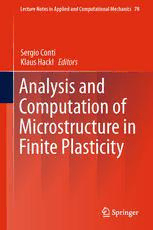Table Of ContentLecture Notes in Applied and Computational Mechanics 78
Sergio Conti
Klaus Hackl Editors
Analysis and
Computation of
Microstructure in
Finite Plasticity
Lecture Notes in Applied and Computational
Mechanics
Volume 78
Serieseditors
FriedrichPfeiffer,TechnischeUniversitätMünchen,Garching,Germany
e-mail:[email protected]
PeterWriggers,UniversitätHannover,Hannover,Germany
e-mail:[email protected]
AboutthisSeries
Thisseriesaimstoreportnewdevelopmentsinappliedandcomputationalmechan-
ics- quickly,informallyandata highlevel.Thisincludesthe fieldsoffluid,solid
andstructuralmechanics,dynamicsandcontrol,andrelateddisciplines.Theapplied
methodscanbeofanalytical,numericalandcomputationalnature.
Moreinformationaboutthisseriesathttp://www.springer.com/series/4623
·
Sergio Conti Klaus Hackl
Editors
Analysis and Computation
of Microstructure in Finite
Plasticity
ABC
Editors
SergioConti KlausHackl
Inst.fürAngewandteMathematik LehrstuhlfürMechanik-Materialtheorie
UniversitätBonn Ruhr-UniversitätBochum
Bonn Bochum
Germany Germany
ISSN1613-7736 ISSN1860-0816 (electronic)
LectureNotesinAppliedandComputationalMechanics
ISBN978-3-319-18241-4 ISBN978-3-319-18242-1 (eBook)
DOI10.1007/978-3-319-18242-1
LibraryofCongressControlNumber:2015937885
SpringerChamHeidelbergNewYorkDordrechtLondon
(cid:2)c SpringerInternationalPublishingSwitzerland2015
Thisworkissubjecttocopyright.AllrightsarereservedbythePublisher,whetherthewholeorpartof
thematerialisconcerned,specificallytherightsoftranslation,reprinting,reuseofillustrations,recitation,
broadcasting,reproductiononmicrofilmsorinanyotherphysicalway,andtransmissionorinformation
storageandretrieval,electronicadaptation,computersoftware,orbysimilarordissimilarmethodology
nowknownorhereafterdeveloped.
Theuseofgeneraldescriptivenames,registerednames,trademarks,servicemarks,etc.inthispublication
doesnotimply,evenintheabsenceofaspecificstatement,thatsuchnamesareexemptfromtherelevant
protectivelawsandregulationsandthereforefreeforgeneraluse.
Thepublisher,theauthorsandtheeditorsaresafetoassumethattheadviceandinformationinthisbook
arebelievedtobetrueandaccurateatthedateofpublication.Neitherthepublishernortheauthorsor
theeditorsgiveawarranty,expressorimplied,withrespecttothematerialcontainedhereinorforany
errorsoromissionsthatmayhavebeenmade.
Printedonacid-freepaper
SpringerInternationalPublishingAGSwitzerlandispartofSpringerScience+BusinessMedia
(www.springer.com)
Preface
ThepresentvolumepresentsresearchcarriedoutwithintheresearchgroupFOR797
“Analysisandcomputationofmicrostructureinfinite plasticity” (MICROPLAST),
financed by the German Science Foundation (DFG). The research group was es-
tablishedin 2007andcame to an endin 2015.Duringthisperiodmorethatthirty
researcherscontributedactivelytothisendeavor,organizedineightsub-projects.
The aim of MICROPLAST was to understandand modeldislocation based mi-
crostructureformationand evolutionin materials, anddeveloptools to computeit
effectively.This is importantbecause plasticity determinesa numberof industrial
and natural phenomena, ranging from the deformation of the earth crust to form-
ingofmetals.Mostplasticprocessesarestronglyinfluencedbytheformationand
evolution of dislocation patterns and other plastic microstructures. Classical plas-
ticity modelswereable to make usefulpredictionswithoutaccountingforthe mi-
crostructure,andfocusingonaphenomenologicalunderstandingofthemacroscopic
material response. These models have, however, strong limitations, concerning in
particular the transferabilityof the results, the applicability to large deformations,
tosmallsamples,andthetreatmentofageingandfatigue.
The foundationof MICROPLAST was inspired both by new mathematical and
modeling developments and by new experimental techniques. Around the turn of
the millenniumnovelvariationalconceptsbecameavailableallowingto formulate
finiteplasticityandassociatedmicrostructureformationwithinarigorousandpow-
erfulmathematicalframework.The systematic variationalformulationof the evo-
lutionofinternalvariablesviadissipationpotentialsanddissipationdistancesmade
itpossibletoapplytheconceptsofrelaxationtheoryandΓ-convergence,thatwere
originallydevelopedforstaticproblems,totheevolutionofinelasticmaterials.
Atthesame timeexperimentaltechniqueshadadvancedto astagewhereitbe-
came possibleto performin situ measurementsof dislocationmicrostructuresand
their evolution, thus giving valuable information for the development of the cor-
respondingmodels.Forthisreason,MICROPLAST wasestablishedasaninterdis-
ciplinary cooperation of scientists from the fields of mathematics, mechanics and
materialssciences,workingcloselytogetheronacommongoal.
VI Preface
This volume contains reports on the various achievements reached within
MICROPLAST. These range from experimental evidence on the mechanisms of
microstructureformationto micromechanicaland multiscale modelsof these pro-
cesses.Theyincludederivationsofrelaxedenvelopesofnon-convexenergiesusing
noveldevelopmentsofvariationalcalculus,aswellasfullmathematicalanalysisof
themodelsestablished,andthedevelopmentofsuitableandfastnumericalschemes.
Itisourhopethatwesucceededingivinganinsightintoanewdevelopingfield,
andthatthereaderswillfindthematerialinthisvolumeinterestingandbeneficial
fortheirresearch.
Thecontributionsinthisvolumehaveundergoneaninternalpeer-review.Weare
convincedthatthisprocessledtosignificantimprovementsinthepaperscontained
inthisbook.
Finally,wewouldliketothanktheGermanScienceFoundationfortheirgenerous
supportandthealwaysverypleasantandprofessionalcooperation.
April2015 SergioConti
KlausHackl
Contents
1 NumericalAlgorithmsfortheSimulationofFinitePlasticitywith
Microstructures ............................................. 1
CarstenCarstensen,DietmarGallistl,BorisKrämer
1.1 Introduction............................................. 1
1.2 PreliminariesandNotation ................................ 3
1.3 ConvergentAdaptiveFiniteElementMethodfortheTwo-Well
ProbleminElasticity ..................................... 4
1.3.1 ReviewoftheModelProblem ...................... 5
1.3.2 AdaptiveAlgorithm .............................. 6
1.3.3 ConvergencefortheDeformationGradient ........... 9
1.4 GuaranteedLowerEnergyBoundsfortheTwo-WellProblem ... 10
1.4.1 NonconformingFEMandDiscreteEnergy
Functional...................................... 10
1.4.2 LowerEnergyBounds ............................ 12
1.4.3 GuaranteedErrorControlforthePseudo-stress........ 15
1.4.4 NumericalExperiments ........................... 16
1.5 DiscontinuousGalerkinMethodfor DegenerateConvex
MinimizationProblems ................................... 17
1.5.1 OptimalDesignBenchmark........................ 18
1.5.2 DiscontinuousGalerkinMethods ................... 20
1.5.3 LiftingOperatorR ............................... 20
1.5.4 ConnectionwiththeNonconformingMethod ......... 21
1.5.5 AdaptiveFiniteElementMethod.................... 22
1.5.6 ComputationalExperiments........................ 22
1.5.7 Γ-shapedDomain ................................ 23
1.5.8 SlitDomain ..................................... 24
1.6 ConclusionsandOutlook.................................. 25
VIII Contents
2 VariationalModelingofSlip:FromCrystalPlasticitytoGeological
Strata...................................................... 31
SergioConti,GeorgDolzmann,CarolinKreisbeck
2.1 Introduction............................................. 31
2.2 ExperimentalObservationofSlipMicrostructuresinNature .... 33
2.2.1 ChevronFoldsinRocks ........................... 34
2.2.2 KinkBandsinStacksofPaperunderCompression..... 34
2.2.3 SimpleLaminatesinShearExperimentsinCrystal
Plasticity........................................ 36
2.3 TheHunt-Peletier-WadeeModelforKinkBands .............. 37
2.4 VariationalModelingofMicrostructure...................... 38
2.5 ModelsinCrystalPlasticitywithOneActiveSlipSystem ...... 41
2.5.1 VariationalFormulationofCrystalPlasticity.......... 42
2.5.2 RelaxationResultsinCrystalPlasticitywithOne
SlipSystem ..................................... 44
2.5.3 HeuristicOriginoftheLaminates................... 46
2.5.4 RelationtoKinkBandsinRocks.................... 49
2.5.5 ElasticApproximation ............................ 51
2.5.6 Higher-OrderRegularizations ...................... 52
2.6 BeyondOneSlip-System.................................. 53
2.6.1 TwoSlipSystemsinaPlane ....................... 53
2.6.2 ThreeSlipSystemsinaPlane ...................... 54
3 Rate-IndependentversusViscousEvolutionofLaminate
MicrostructuresinFiniteCrystalPlasticity ...................... 63
ChristinaGünther,DennisM.Kochmann,KlausHackl
3.1 Introduction............................................. 63
3.2 VariationalModelingofMicrostructures..................... 64
3.3 SingleSlipCrystalPlasticity............................... 67
3.4 PartialAnalyticalRelaxationviaLamination ................. 67
3.5 Rate-IndependentEvolution ............................... 70
3.5.1 EvolutionEquations .............................. 70
3.5.2 LaminateRotation................................ 71
3.5.3 LaminateInitiation ............................... 72
3.5.4 NumericalScheme ............................... 72
3.6 SimulationofRotatingLaminates .......................... 73
3.7 ViscousEvolution........................................ 75
3.7.1 EvolutionEquations .............................. 76
3.7.2 LaminateRotation................................ 77
3.7.3 LaminateInitiation ............................... 77
3.8 Comparison of the Laminate Evolution for the Rate-
IndependentCaseandtheViscosityLimit.................... 78
3.9 ConclusionandDiscussion ................................ 85
Contents IX
4 VariationalGradientPlasticity:Local-GlobalUpdates,
RegularizationandLaminateMicrostructuresinSingleCrystals .... 89
SteffenMauthe,ChristianMiehe
4.1 Introduction............................................. 90
4.2 AMultifieldFormulationofGradientCrystalPlasticity ........ 93
4.2.1 IntroductionofLong-RangeFieldVariables .......... 93
4.2.2 IntroductionofShort-RangeFieldVariables .......... 96
4.2.3 EnergyStorage,DissipationPotentialandLoad
Functionals...................................... 99
4.2.4 Rate-TypeVariationalPrincipleandEulerEquations ... 102
4.2.5 ExplicitFormoftheMicro-forceBalanceEquations ... 103
4.3 AlgorithmicFormulationofGradientCrystalPlasticity......... 103
4.3.1 Time-DiscreteFieldVariablesinIncrementalSetting... 103
4.3.2 Update Algorithmsfor the Short-RangeField
Variables........................................ 104
4.3.3 Time-DiscreteIncrementalVariationalPrinciple....... 105
4.3.4 Space-Time-Discrete IncrementalVariational
Principle........................................ 106
4.4 Example1:AnalysisofanF.C.C.CrystalGrainAggregate...... 108
4.4.1 SlipSystemsandEulerAngles ..................... 108
4.4.2 Voronoi-TessellatedUnitCellunderShear............ 109
4.5 Example2:LaminateMicrostructureinSingleCrystals ........ 110
4.5.1 DoubleSlipSystems.............................. 111
4.5.2 ImplicationsofSamePlaneDoubleSlip ............. 112
4.5.3 LaminateDeformationMicrostructureinSingle
CrystalCopper .................................. 114
4.6 Conclusion.............................................. 118
5 VariationalApproachesandMethodsforDissipativeMaterial
ModelswithMultipleScales ................................... 125
AlexanderMielke
5.1 Introduction............................................. 125
5.2 VariationalFormulationsforEvolution ...................... 127
5.2.1 GeneralizedGradientSystems andthe Energy-
DissipationPrinciple.............................. 128
5.2.2 Rate-IndependentSystemsandEnergeticSolutions .... 132
5.3 EvolutionaryΓ-Convergence .............................. 134
5.3.1 pE-convergenceforGeneralizedGradientSystems..... 134
5.3.2 pE-convergenceforRate-IndependentSystems........ 137
5.4 JustificationofRate-IndependentModels .................... 138
5.4.1 WigglyEnergiesGiveRisetoRate-Independent
Friction ........................................ 139
5.4.2 1DElastoplasticityasLimitofaChainofBistable
Springs ......................................... 141

